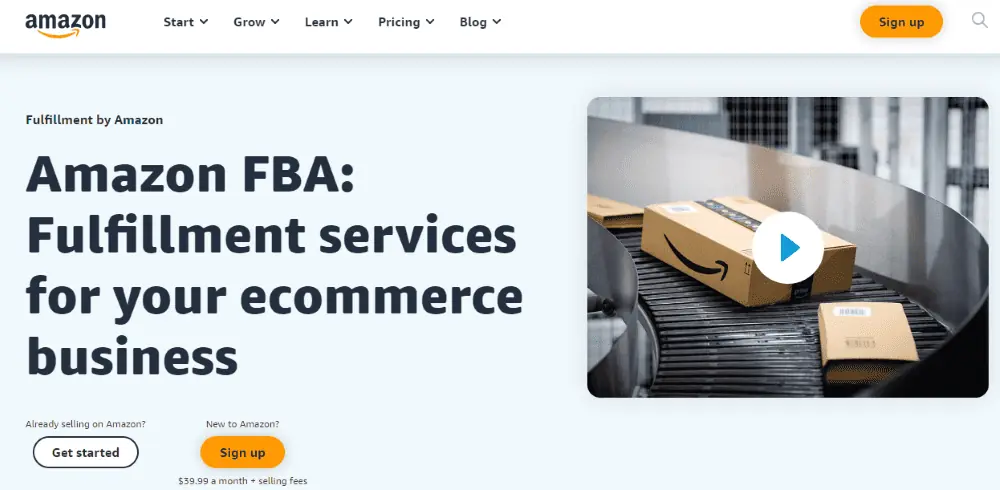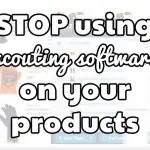Article Summary (TL;DR)
✅ Key factors affecting sellers’ earnings include product selection, pricing and margins, marketing efforts, fulfillment methods, customer reviews, competition, seasonality, brand reputation, investment, and international expansion.
✅ Insights into estimating potential earnings on Amazon, categorizing sellers into low, moderate, and high earners based on annual revenue. It also touches on profit margins across different product categories.
✅ A step-by-step guide for new sellers, covering market research, product selection, creating a seller account, sourcing products, listing creation, fulfillment methods, SEO optimization, pricing strategies, promotion, customer service, performance tracking, and scaling.
✅ How sellers can calculate their potential earnings by estimating sales volume, revenue, deducting costs, and forecasting over time while considering risks and uncertainties.
Are you curious about how much do Amazon sellers make?
The world of e-commerce has witnessed a remarkable transformation in recent years, with Amazon standing at the forefront as a dominant force in the online retail landscape. For countless entrepreneurs and businesses, selling on Amazon has become not just an opportunity but a necessity to thrive and become profitable even in the digital age.
The allure of Amazon’s vast customer base, seamless fulfillment services average monthly sales amount, and global reach has drawn in a diverse array of sellers, from small-scale entrepreneurs to established brands. But the pivotal question remains: How much can an Amazon seller actually make?
Understanding the financial impact of selling on Amazon and its significance in the realm of online businesses is a journey that explores the intricacies of product selection, pricing strategies, competition, and the ever-evolving dynamics of the e-commerce business on Amazon’s giant’s platform.
In this exploration, we will delve into the factors that influence an Amazon seller’s earnings and the broader implications of Amazon’s role in shaping the digital marketplace.
Key Factors that Affect the Earning Potential of Amazon Sellers

There’s a way to make money in online business. One is to make a successful Amazon business. The amount of money businesses make on Amazon can vary significantly depending on various factors, including the type of products they sell, their marketing efforts, their pricing strategies, and their overall business model.
An average Amazon seller can make lifetime profits if he knows how to manage his Amazon and business expenses properly.
Here are some key factors that influence how much money some businesses can make on Amazon:
Product Selection
One of the biggest factor in starting a healthy Amazon business is having a good product. The choice of products is critical. Niche products with high demand and low competition can yield higher profits. Popular categories include electronics, apparel, beauty, and home goods.
Pricing and Margins
Competitive pricing is essential. Businesses must consider factors like manufacturing costs, Amazon’s fees (including referral fees and fulfillment fees), and shipping costs when setting prices. Maintaining healthy profit margins is key.
Marketing and Promotion
Effective marketing strategies, including pay-per-click (PPC) advertising, search engine optimization (SEO), and social media promotion, can drive more traffic and sales. A well-executed marketing plan can significantly impact earnings.
Fulfillment Method
Businesses can choose between Fulfillment by Amazon (FBA), where Amazon handles storage, packing, and shipping, or Fulfillment by Merchant (FBM), where the seller manages these aspects. FBA can lead to higher sales due to Prime eligibility and faster shipping but involves additional fees.
Customer Reviews and Ratings:
Positive reviews and high product ratings can boost sales. Providing excellent customer service and addressing issues promptly is crucial for maintaining a positive reputation.
Competition:
The level of competition in a particular niche or product category can affect sales and profit potential. Entering less competitive niches may lead to faster growth.
Seasonality:
Some products experience seasonal fluctuations in demand monthly sales. Businesses that sell seasonal products need to plan for revenue variations throughout the year.
Brand Reputation:
Established brands and retail stores often have an advantage on Amazon. Building a strong brand presence can lead to customer loyalty and repeat purchases.
Investment and Resources:
Businesses willing to invest in inventory, advertising, and professional services (like product photography or copywriting) may see greater returns.
International Expansion:
Expanding to international Amazon marketplaces can open up new revenue streams, but it also involves adapting to different market conditions and regulations.
How Much Do Amazon Sellers Make? Estimated Potential Earning

The earnings of Amazon sellers can vary widely and depend on numerous factors. These factors include the type of products they sell, their sales volume, pricing strategies, fulfillment method, marketing efforts, competition, and more. Here’s a breakdown of the range of earnings you might find among Amazon sellers:
- Low Earnings (Part-Time or Small-Scale Sellers):
- Part-time or hobbyist sellers may earn a few hundred to a few thousand dollars per month.
- Small-scale sellers may generate annual revenues ranging from $10,000 to $50,000.
- Moderate Earnings (SMBs and Growing Businesses):
- Small and medium-sized businesses (SMBs) often earn between $50,000 and $1 million in annual revenue.
- Many businesses fall into this category, which can include one-person operations or small teams managing multiple products.
- High Earnings (Large and Established Sellers):
- Large and established sellers can earn millions or even billions of dollars in annual revenue.
- These sellers often have extensive product catalogs, strong brand recognition, and significant resources for marketing, advertising, and inventory management.
It’s important to note that success on Amazon often requires ongoing effort, adaptability, and a commitment to providing a positive customer experience. Earnings can vary widely, from a few thousand dollars per year for small businesses to millions or even billions of dollars per year for large, established brands.
Ultimately, the amount a business makes on Amazon depends on how long does it take its unique circumstances, strategies, and market dynamics.
What’s the Average Profit Margin for Different Categories in Amazon

The average profit for categories of items on Amazon can vary significantly based on several factors, including the type of product, competition, pricing strategy, and fulfillment method.
Amazon does not publicly disclose category-specific average profit margins, and the profitability of products within the same percent of sellers’ profits within the same category can also vary widely. However, here’s a general overview of profit considerations for profits within some common Amazon categories:
Electronics and Gadgets:
Electronics can have relatively low profit margins due to price competition and rapid product obsolescence. Sellers often focus on high-volume sales to compensate for lower margins.
Books and Media:
- Profit margins for books and media (e.g., DVDs, CDs) can be modest, especially for used items. Sellers may rely on a large inventory to generate substantial revenue.
Clothing and Fashion:
- Fashion items can have varying profit margins, with higher-end or niche fashion often commanding better margins. However, competition can be fierce in this category.
Health and Beauty:
- Profit margins in health and beauty can be favorable, particularly for niche or specialty products. Private label brands are also common in this category.
Home and Kitchen:
- Home and kitchen products can offer good profit margins, especially for unique or branded items. Private label products are prevalent here.
Toys and Games:
- Profit margins can vary in the toy and game category. Some popular toys may have lower margins due to competition, while niche or unique items can offer better margins.
Automotive and Industrial:
- This category includes a wide range of products with varying margins. Parts and accessories for specific vehicles can offer good margins, while highly competitive items may have lower margins.
Sports and Outdoors:
- Profit margins in this category can range from low to high, depending on the product. Niche or specialized sports equipment may have better margins.
Jewelry and Watches:
- Jewelry and watches often have relatively high profit margins, especially for branded or luxury items. However, competition can be strong.
Electronics Accessories:
- Accessories like phone cases, chargers, and cables can offer decent profit margins, particularly for private label or unique products.
Grocery and Gourmet Food:
- Grocery items often have low profit margins due to competition and the perishable nature of some products. High-end or specialty food products may offer better margins.
It’s important to note that these are general trends, and individual seller experiences can vary widely within each category.
Sellers’ profit margins are influenced by factors such as sourcing costs, pricing strategies, fulfillment fees, advertising costs, and the level of competition in their specific niche or product segment.
Before entering a specific category start selling anything on Amazon, sellers should conduct thorough research, calculate potential costs, and carefully consider their pricing and marketing strategies to determine their expected profit margins.
Additionally, private labeling and building a strong brand presence can sometimes lead to better profitability in competitive categories.
🗣️ Pro Tip: Market research for Amazon can start with picking a niche in the product categories.
How Can New Sellers Start to Make a Living Out of Amazon
Starting to make a living as a new seller on Amazon can be an exciting but challenging endeavor for new sellers. Success on Amazon often requires careful planning, dedication, and a strong understanding of the e-commerce platform. Here’s a step-by-step guide for new sellers looking to get started and build a profitable Amazon business:
Market Research:
- Begin by researching different product categories and niches on Amazon.
- Use tools like Amazon’s Best Sellers list, Jungle Scout, or Helium 10 to identify products with demand and manageable competition.
- Consider factors like product pricing, competition, and seasonality.
Select Profitable Products:
- Choose products that offer a good balance between demand and competition.
- Focus on products that have the potential for healthy profit margins.
- Consider starting with a niche you are knowledgeable about or passionate about.
Create a Seller Account:
- Sign up for an Amazon Seller account. You can choose between an Individual Seller account (suitable for low-volume sellers) or a Professional Seller account (ideal for high-volume sellers).
- Complete the necessary account setup, including providing business information and payment details.
Source Products:
- Decide whether you’ll source products through wholesale, private labeling, dropshipping, or retail arbitrage.
- Establish reliable suppliers and ensure the quality of your products.
Listing Creation:
- Create high-quality product listings with clear titles, detailed descriptions, high-resolution images, and competitive prices.
- Use relevant keywords in your product listings to improve visibility in Amazon’s search results.
Fulfillment Method:

- Choose between Fulfillment by Amazon (FBA) or Fulfillment by Merchant (FBM).
- FBA offers convenience and access to Prime customers, but FBM allows for greater control over fulfillment.
Optimize for SEO:
- Implement effective SEO (search engine optimization) strategies to improve your product’s visibility on Amazon.
- Use keyword-rich product titles, bullet points, and product descriptions.
Set Pricing Strategies:
- Determine competitive yet profitable pricing for your products.
- Consider using automated repricing tools to stay competitive.
Promotion and Marketing:
- Invest in marketing strategies such as Amazon PPC (Pay-Per-Click) advertising to drive initial traffic.
- Utilize social media and external marketing channels to promote your products.
Customer Service:
- Provide exceptional customer service to build trust and positive reviews.
- Address customer inquiries and resolve issues promptly.
Track and Analyze Performance:
- Use Amazon’s reporting tools to monitor your sales, revenue, and profitability.
- Analyze customer feedback and reviews to improve your product listings and overall business.
Scale and Expand:
- Once you’ve established a profitable product line, consider expanding your catalog or entering new niches.
- Explore international markets by selling on Amazon’s global marketplaces.
Stay Informed:
- Stay updated on Amazon policies, industry trends, and best practices to adapt to changes and optimize your business.
Building a sustainable business on Amazon takes time and effort.
Be prepared to learn from your experiences, adapt your strategies, make money, and continuously optimize your listings and operations. With dedication and a commitment to delivering value to customers, you can get started and work toward making a living as an Amazon seller.
How to Calculate Potential Earnings in Amazon

Calculating potential earnings as an Amazon seller involves a mix of research, estimation, and data analysis. Here are the steps you need to start to compute potential earnings on Amazon:
- Market Research:
- Begin by identifying a profitable niche and the products or product categories you plan to sell on Amazon.
- Use tools like Amazon’s Best Sellers list, Jungle Scout, or Helium 10 to gather data on sales rankings, prices, and competition within your chosen niche.
- Research trends and seasonality in your product category to understand demand fluctuations.
- Estimate Sales Volume:
- Estimate the number of units you expect to sell each month. Look at the sales ranks of similar products to gauge demand.
- Consider factors like product pricing, competition, and the effectiveness of your marketing strategies when making this estimation.
- Calculate Revenue:
- Multiply your estimated monthly sales volume by the selling price of your product to calculate your monthly revenue for that product.
- Repeat this calculation for each product you plan to sell.
- Deduct Costs:
- Make sure to calculate Amazon fees. Deduct the various costs associated with selling on Amazon. These may include:
- Amazon’s referral fees, which vary by product category.
- Amazon FBA fees if you use their fulfillment service.
- Cost of goods sold (COGS), which is the cost to acquire or manufacture the products.
- Shipping and logistics costs.
- Advertising and marketing expenses.
- Amazon subscription fees (if you have a Professional Seller account).
- Make sure to calculate Amazon fees. Deduct the various costs associated with selling on Amazon. These may include:
- Calculate Net Profit:
- Subtract the total costs from your total revenue to calculate your net profit.
- Keep in mind that net profit can vary based on your fulfillment method (FBA or FBM) and other operational expenses.
- Forecast Over Time:
- Extend your calculations to forecast potential earnings over a longer period, such as a year.
- Consider seasonality, holidays, and trends that may impact sales volume and pricing.
- Optimize and Refine:
- Continuously optimize your Amazon business by adjusting pricing, advertising, and product selection based on real-time performance data.
- Experiment with strategies to increase sales, reduce costs, and improve profit margins.
- Consider Risk and Uncertainty:
- Be aware that there are risks and uncertainties in e-commerce, such as changes in market conditions, competition, and unforeseen expenses.
- Maintain a financial cushion to cover unexpected costs or fluctuations in sales.
- Track and Adjust:
- Regularly track your actual sales, revenue, and expenses on Amazon. Compare these figures to your initial projections.
- Adjust your strategies and forecasts based on real-world performance and market dynamics.
Calculating potential earnings on Amazon is an ongoing process that requires regular monitoring and adjustments. It’s important to approach your Amazon business with a flexible mindset and adapt your strategies as needed to maximize your profitability over time.
Final Words
You can make money online through Amazon selling. The annual sales of Amazon sellers are as diverse and dynamic as the vast e-commerce ecosystem itself. From entrepreneurs starting small-scale ventures to established brands expanding their reach, the potential income on Amazon is influenced by numerous factors. It depends on product selection, pricing strategies, fulfillment methods, competition, marketing efforts, and the ability to adapt to changing market conditions.
For some, selling on Amazon is a side hustle and may provide supplementary income, while for others, it can become a substantial source of revenue. Successful sellers often combine diligent market research, strategic planning, and a commitment to customer satisfaction to build profitable businesses.
The potential earnings as an Amazon seller are shaped by the seller’s unique circumstances, efforts, and ability to navigate the complexities of the e-commerce landscape. Whether one aims for modest supplementary income or a full-time living, the journey as an Amazon seller is a dynamic and evolving path that offers opportunities for success and growth.
Comments
Related Posts
Mastering Shopify’s UTMs: The Simple Way to Smarter Marketing
Let’s be honest: marketing your Shopify store without tracking what’s…

10 Profitable Product Categories for Amazon Affiliates 2025
What you’ll learn Amazon is a favorite for experienced and…

Unlock the Secret to a Profitable Automated Amazon Store: How to Build a Hands-Free Income Stream
Ever dreamed of running a profitable Amazon business while sipping…







Leave a Reply